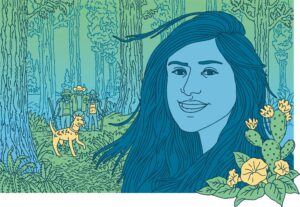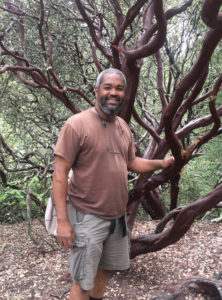Mia Monroe’s official title is Site Supervisor of Muir Woods/Interpretive Supervisor of Marin Lands, Golden Gate National Recreation Area. But what she really does is serve as a passionate ambassador for nature, something she was doing even before she started working as a national park ranger in 1978. Her office at Muir Woods is decorated with butterfly mobiles, redwood branches, and pictures of flowers and insects. It’s a scene of fertile chaos, with old growth redwoods visible through the window. This is Mia’s platform for introducing countless Bay Area residents and visitors to the wonders of a rich and unique natural ecosystem just minutes from downtown San Francisco.
BN: Where did you grow up and how did you interact with nature as a child?
MM: I grew up in San Carlos, just south of San Francisco, and came from a family that respected and loved and sought out natural connections. We often went to the beach for tidepooling. And we went for picnics and camping in the redwoods. Even when we were at home, my parents sometimes got me up in the middle of the night to see shooting stars or migrating geese. When there was a field of wildflowers by the road, my parents would pull over and have us lie in the flowers and breathe in the perfume and hear the buzzing of the bees. At home, my mother had a garden and my grandmother would take us on little tours of it to appreciate everything from the slugs to the squirrels.
BN: What led you to become a park ranger?
MM: As a young person I had many role models. My parents were involved in all the issues of the time, from civil rights to prisoners’ rights. I was also in the Girl Scouts and was part of an active troop that went on hikes and had day camps in the redwood forest. But my family also believed that doing community service was right up there with learning how to build a campfire. Of course, the timing was perfect. The Bay Area was very exciting in the ’60s for a child who was interested in nature. I organized the first Earth Day at my high school, and my mom let me set up the first recycling center in San Carlos in our basement. In college I needed to do an internship so I went to the Sierra Club and said, “Put me to work!” And they sent me to Amy Meyer, a citizen turned visionary activist who was working out of her dining room on the campaign to protect the land around the Golden Gate by making it a national park. And she did indeed “put me to work”! That was in the early 1970s. Shortly thereafter, the Golden Gate National Recreation Area was created, and it was great to have this major public park in an urban area, lands that belonged to everybody, that anyone could have access to. Not only to recreate – take a hike, ride your bike – but also to re-create, to see a better future, be healthier, take a break from the cares of urban life.
BN: How did you start working with the GGNRA?
MM: I had been working for the San Francisco School District helping kids learn science through outdoor experiences, including at these new national park sites. When Proposition 13 put an end to that program, someone at the park service said, “Where’s that girl who brought the kids? Let’s call her.” So that’s why the [park service] thought I’d make a good ranger and sought me out. Part of it was my eco-literacy but part of it was that passion I had for sharing parks with other people, which was what they were trying to do. My first supervisor would have me wear my uniform on the city buses so kids would realize that if I could go to their neighborhood, they could come to mine and I’d be there to greet them.
My first assignment was as a ranger at Fort Point at the Golden Gate, where I coordinated the environmental education programs for young people. But my supervisor knew of my forestry background and interest in nature, and there was a ranger at Muir Woods who loved military history, so they suggested that we trade for a while. And the fit was so good for both of us that we made the trade permanent and I was formally stationed at Muir Woods in 1982.
I was very idealistic when I first came here and I was sort of shocked by all the paths and the concession. But then I realized that Muir Woods has a special role because it’s not very far from San Francisco or Oakland, so it’s very easy to get to and yet it feels like a world apart. You were stepping into a very beautiful place that smelled wonderful and took your breath away and was safe. And thanks to the way the park was laid out, anybody could visit: Families felt comfortable bringing their elderly grandparents or children in strollers. But all was not right in paradise. There were non-native plants, weeds. The salmon population was declining. So even though it looked really beautiful, everything was not whole – inadvertently, along the way, some of the pieces had been thrown out or overlooked. So that’s really been my work for these many years – to be part of the teams that re-weave the ecosystem here and to help actively engage citizens in that process. It’s been a dawning awareness that we have to take care of not just the individual redwoods but also the forest and the watershed.
BN: What do you love most about your job?
MM: I feel so fortunate to work in a place that’s so beautiful and so nurturing and makes my sprit soar. I’m a little unusual in that I’m a career ranger and I’m still working in the field. My office has green walls. I breathe in the fresh air, I see the cycles of nature, I greet the first spring flowers and the nesting birds.
I’ve been here when redwoods have fallen. To contemplate something that’s been standing for hundreds of years taking a new position in the forest – the smell and how soon afterwards the birds and butterflies find the new sunny spot, and seeing all the redwoods grow to that new light – there’s something about the change in a forest that’s truly awesome. I’ve been here when the salmon are spawning; it’s thrilling to see them make their way up the stream, to witness that ancient ritual of the spawning cycle.
And then, I’ve taken a lot of young people through here. I can hardly wait to introduce them to their first banana slug or show them how to find a redwood seed or show them where to go to find a flower or a butterfly, to show kids how to find those clues so they feel comfortable being their own explorers in nature.





